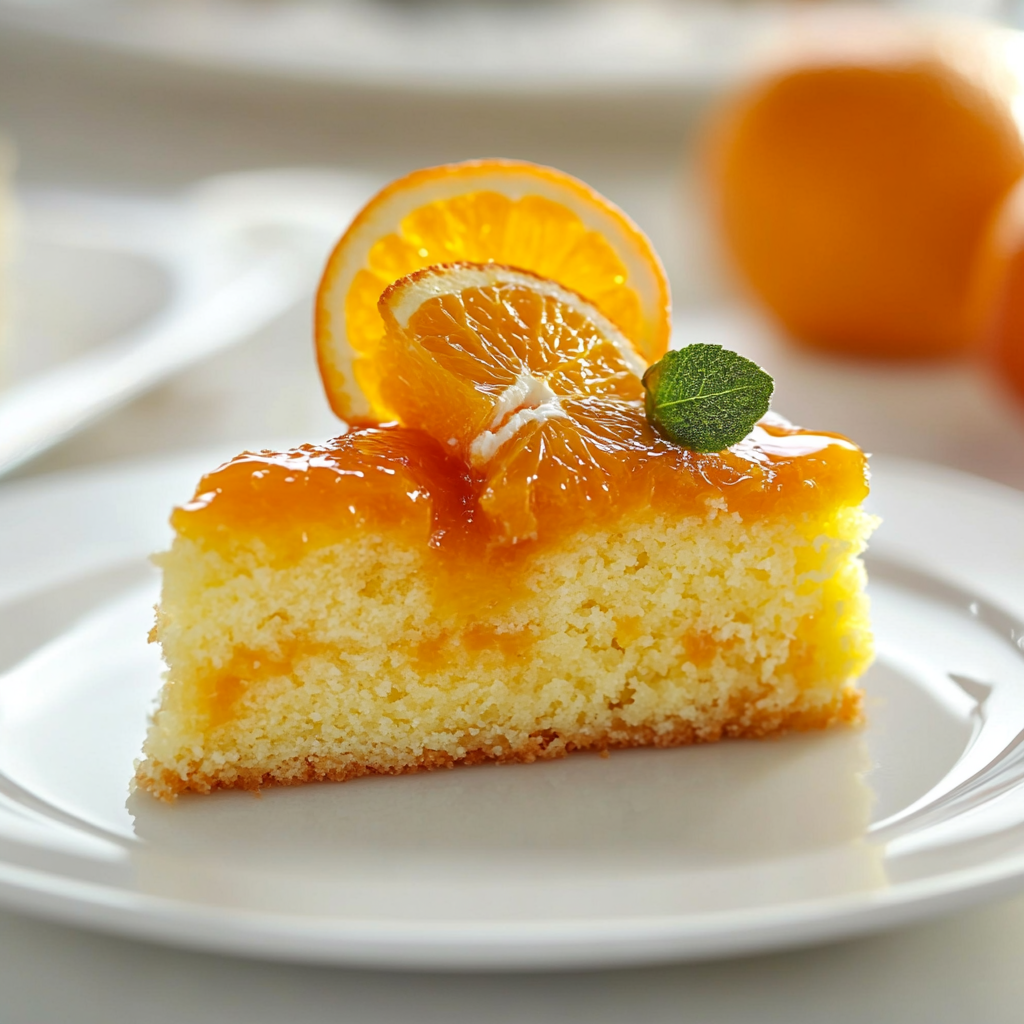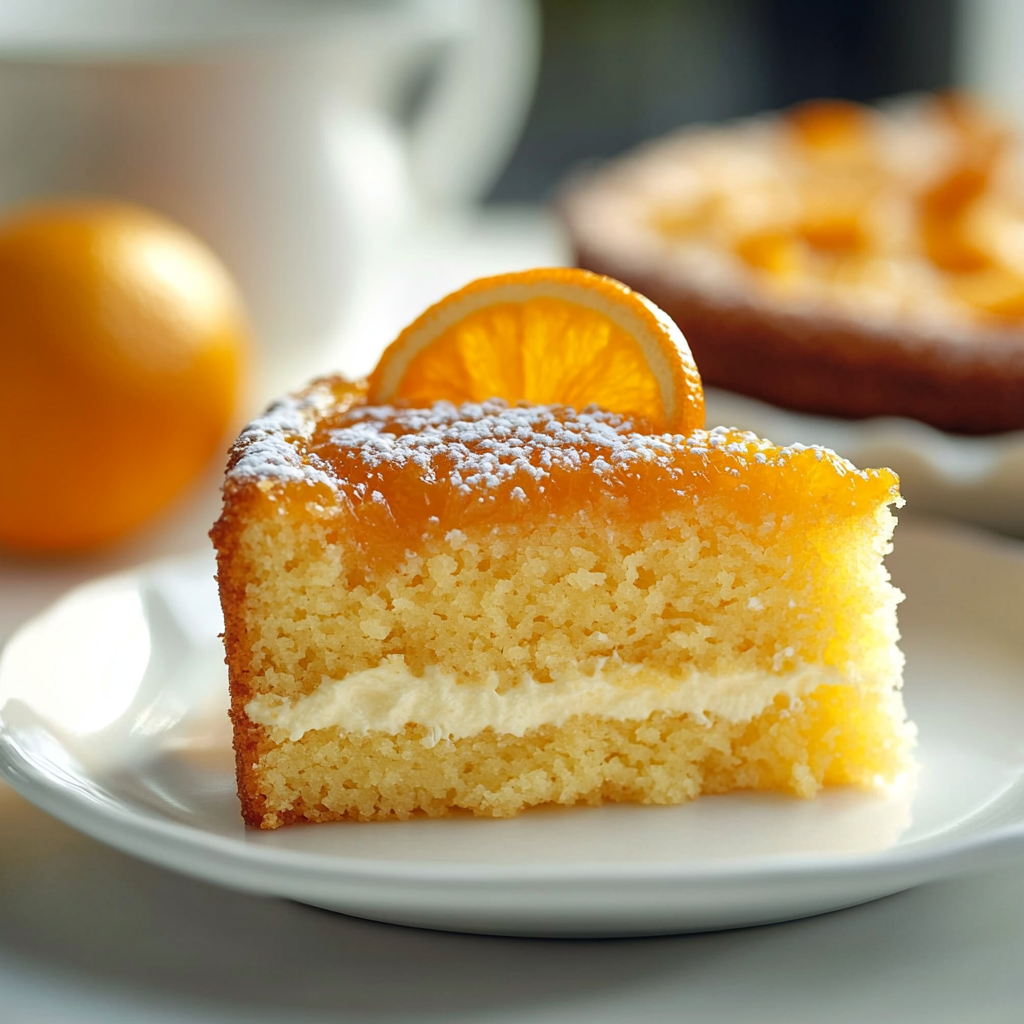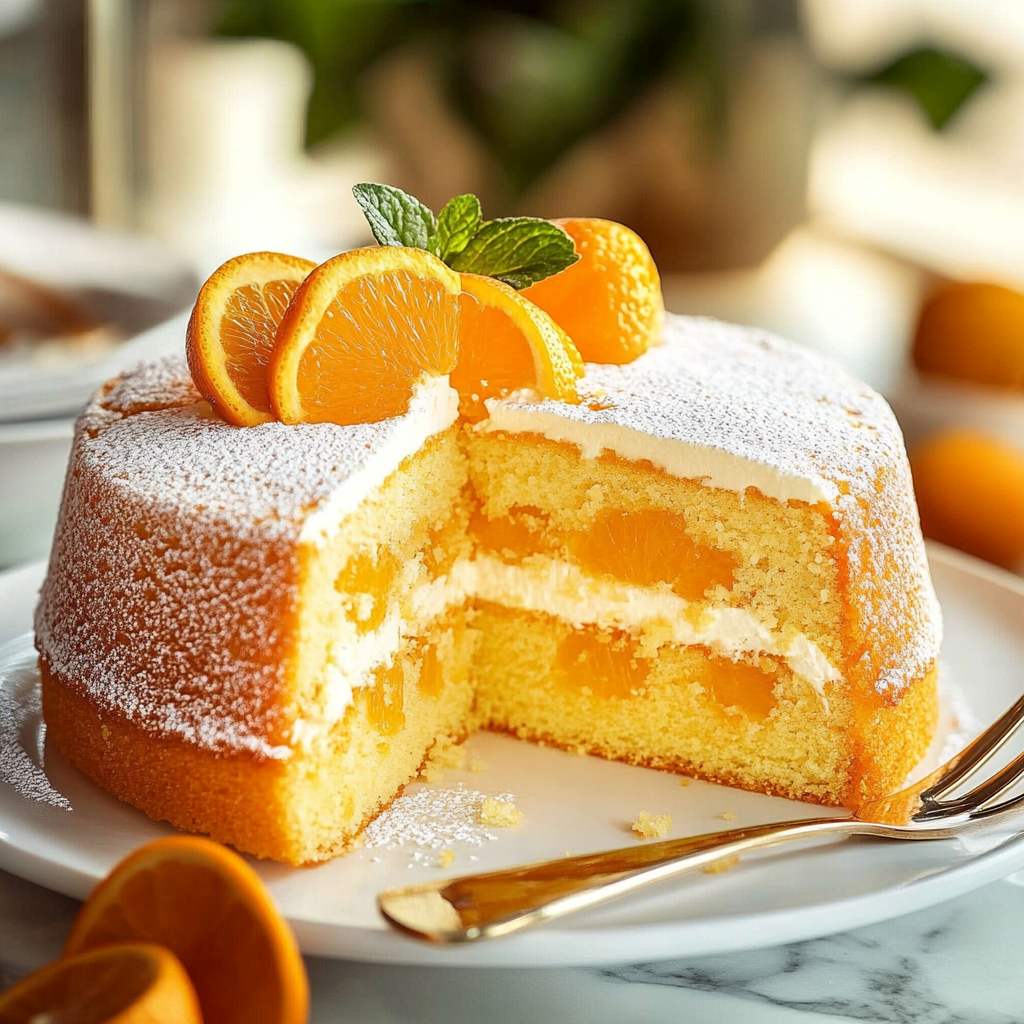Welcome to the world of baking where every bite tells a story! Today, we’re diving into a delightful recipe for an orange cake that will brighten your day with its zesty flavor and moist texture. This orange cake is perfect for any occasion—be it a birthday party, family gathering, or simply as an afternoon treat with tea. The vibrant taste of fresh oranges combined with the light sweetness of the cake makes it irresistible.

In this article, you will discover how to create the perfect orange cake from scratch. Not only will we provide step-by-step instructions, but we’ll also explore the essential ingredients that bring this dessert to life. This recipe is designed for bakers of all skill levels, so whether you are a beginner or an experienced baker looking to refine your skills, you’ll find everything you need right here.
What sets this orange cake apart is its incredible flavor profile and moist crumb. Enhanced by a simple glaze made from fresh orange juice and powdered sugar, it’s sure to impress your friends and family. So roll up your sleeves and get ready to whip up this delicious treat that captures the essence of sunshine in every slice!
Main Ingredients
Fresh Oranges
Fresh oranges are the star ingredient in this recipe. You will need about three medium-sized oranges for both zesting and juicing. The zest adds a delightful aroma and enhances the overall flavor of the cake while the juice keeps it moist and adds sweetness. Choose juicy oranges for the best results; navel oranges work particularly well due to their sweetness.
All-Purpose Flour
All-purpose flour serves as the foundation of our orange cake. You will need approximately two cups (240 grams) for this recipe. It provides structure and stability to the cake without making it too dense. Make sure to sift the flour before measuring it out; this helps prevent clumping and ensures an even texture in your finished product.
Granulated Sugar
For sweetness, granulated sugar is essential in this recipe. You will require one cup (200 grams) of sugar for mixing into the batter and an additional half cup (60 grams) for the glaze later on. Sugar not only sweetens but also contributes to the browning process during baking, giving your cake its lovely golden color.
Unsalted Butter
Using unsalted butter adds richness to our orange cake. You’ll need half a cup (113 grams) of softened butter at room temperature for optimal mixing. The fat content in butter creates a tender crumb while providing essential flavor components that complement the citrus notes beautifully.
Eggs
Eggs are crucial in binding our ingredients together while adding moisture and richness to our dish. You will need four large eggs for this recipe—two eggs added into the batter and two yolks used separately if you choose to enhance richness further with egg yolks.
Baking Powder
Baking powder acts as our leavening agent in this recipe; it helps create that light texture we desire in cakes! You’ll require two teaspoons (8 grams) of baking powder which allows air bubbles to form during baking so that our orange cake rises perfectly.
Milk
To add moisture without overpowering flavors, we include milk—around half a cup (120 ml) should suffice! Whole milk works best here but feel free to substitute with low-fat varieties if preferred.
Powdered Sugar (for Glaze)
Powdered sugar is utilized later on for creating a simple glaze that adds just enough sweetness while enhancing presentation! Around one cup (120 grams) will be needed once mixed with freshly squeezed juice from our earlier-mentioned oranges.

How to Prepare Orange Cake
Step 1: Preheat Your Oven
Begin by preheating your oven to 350°F (175°C). This ensures that when you place your cake batter inside, it starts cooking evenly right away! Meanwhile, prepare two 9-inch round baking pans by greasing them lightly with butter or non-stick spray followed by lining them with parchment paper at the bottom – which prevents sticking during removal post-baking!
Step 2: Prepare Your Ingredients
While waiting for your oven’s temperature to rise, gather all ingredients on your countertop—this simplifies mixing when you start combining everything together! Zest two of your fresh oranges using a fine grater or zester; aim for about one tablespoon worth since zest imparts vibrant citrus notes into each slice! Once done zesting these fruits, chop them into halves before extracting juice using either manual juicer equipment or handheld reamer until you yield around half cup fresh juice—the primary flavor booster!
Step 3: Cream Butter & Sugar
Now let’s mix things up! In large mixing bowl beat together softened unsalted butter along with granulated sugar using electric mixer set on medium speed until mixture appears light pale yellow color—about three minutes should do nicely here! Ensure no lumps remain after blending thoroughly; scraping down sides occasionally helps achieve uniform consistency throughout batters!
Step 4: Incorporate Eggs & Vanilla Extract
Once butter-sugar mixture looks fluffy as desired now add those four large eggs one at a time beating well after each addition until fully incorporated—this allows air pockets form which contributes volume upon baking process later on! After all eggs added blend vanilla extract too; approximately one teaspoon will suffice giving subtle aromatic undertone alongside citrus notes present already!
Step 5: Combine Dry Ingredients
In separate bowl sift together all-purpose flour along with baking powder until well-mixed; doing so helps aerate dry ingredients allowing even distribution throughout batter when combined later on—no clumps should remain at this stage! Gradually fold in flour mixture alternating between dry ingredients & milk—start/end with dry units keeping moisture levels balanced preventing overly dense end result!
Step 6: Add Orange Juice & Zest
Finally fold freshly squeezed orange juice along with zest into prepared batter ensuring every nook gets infused tangy goodness we’re aiming for here! Take care not overmix at this point since gluten activation could lead toughened crumb rather than soft airy texture desired ideally!
Step 7: Bake Your Cake Layers
Now pour evenly divided batter between prepared baking pans smoothing tops gently using spatula ensuring level surfaces achieved across both layers readying themselves against oven heat soon enough! Bake within preheated oven about twenty-five-thirty minutes checking doneness via toothpick inserted center comes out clean indicating successful completion—allow cooling slightly before transferring onto wire racks completely cool off before frosting application occurs next step ahead!

Serving and Storing Tips
Serving Suggestions
When serving your orange cake consider dusting top lightly powdered sugar just prior presenting guests—it adds elegance while providing subtle extra sweetness enhancing visual appeal overall too! Alternatively pair slices alongside fresh whipped cream adding richness alongside brightness provided through citrus flavors present already within dessert itself creating delightful contrast mouthfeel wise too!
For special occasions why not garnish slices using thinly sliced candied oranges placed atop each piece? This adds color vibrancy completes look wonderfully whilst introducing chewy element alongside crunchy textures enjoyed too creating memorable experience every guest remembers fondly long after event ends!
Storing Your Cake
If you happen have leftovers after indulging friends/family don’t worry—they can last quite awhile stored correctly ensuring freshness maintained longer periods possible! To properly store wrap entire cooled un-frosted cakes tightly cling film preventing air exposure leading dryness occurring prematurely over time if left exposed outside elements surrounding them too much unnecessarily causing staleness eventually ruining deliciousness initially intended enjoyed instead!
Alternatively frosted versions should ideally refrigerated within airtight container preventing drying out topping intact preserving moistness present throughout entire layer staying intact longer lasting enjoyment till last crumb devoured happily shared amongst loved ones gathered around table together bonding over treats shared collectively making memories cherished always worth reliving time again undoubtedly forevermore!
Mistakes to Avoid
Not Measuring Ingredients Accurately
One of the most common mistakes when baking an orange cake is not measuring ingredients accurately. Baking is a science, and precision plays a crucial role in achieving the perfect texture and flavor. When you don’t measure your flour, sugar, or liquid components accurately, you could end up with a cake that is too dense or too crumbly. Always use standard measuring cups and spoons, and for dry ingredients, consider using a kitchen scale for the best results. It’s also essential to level off your measuring cups to ensure you’re using the exact amount called for in the recipe. This small step can significantly impact the outcome of your orange cake.
Skipping Room Temperature Ingredients
Another pitfall many bakers face is not allowing their ingredients to reach room temperature before mixing. Ingredients like eggs and butter blend more smoothly and evenly when they are at room temperature. If you add cold butter directly into your batter, it may not cream properly with sugar, leading to uneven cooking and texture issues in your orange cake. To avoid this mistake, take your eggs and butter out of the fridge at least 30 minutes before you start baking. This simple act can elevate the quality of your cake.
Overmixing the Batter
Overmixing can be detrimental to the texture of your orange cake. While it’s important to combine ingredients thoroughly, overmixing can lead to a tough cake because it develops gluten in the flour too much. After adding flour to your mixture, mix just until combined; small lumps are okay. Also, folding in additional ingredients like zest or nuts should be done gently to maintain airiness in your batter. This technique will ensure that your orange cake turns out light and fluffy.
Tips and Tricks
Use Fresh Oranges for Zest and Juice
Using fresh oranges instead of bottled juice makes a world of difference in flavor for your orange cake. Freshly zested fruit provides essential oils that enhance aroma and taste while freshly squeezed juice adds brightness that bottle alternatives simply can’t match. When zesting oranges, be sure only to remove the colored outer layer of the peel—avoiding the bitter white pith underneath—to achieve a sweet citrus flavor. Remember that quality ingredients yield superior results!
Experiment with Flavor Enhancers
While oranges are delightful on their own, consider enhancing their flavor profile by incorporating other complementary ingredients into your orange cake batter. Adding vanilla extract or almond extract can elevate the citrus notes beautifully. Spice elements like cinnamon or nutmeg can also add depth without overshadowing the primary ingredient—orange! Just remember to use these flavor enhancers sparingly; a little goes a long way.
Let Your Cake Cool Properly
Cooling is an often-overlooked step that impacts both presentation and taste in baking. After removing your orange cake from the oven, allow it to cool in its pan for about 10-15 minutes before transferring it to a wire rack for complete cooling. This prevents sogginess from steam trapped beneath while allowing flavors to settle in harmoniously. If you frost or glaze a warm cake, it could melt away; therefore, patience pays off here.
Suggestions for Orange Cake
Pair with Complementary Frostings
Choosing the right frosting can transform your orange cake from good to extraordinary. Citrus-based frostings such as cream cheese frosting add a tangy touch that pairs excellently with sweet orange flavors. Alternatively, try a simple glaze made from powdered sugar mixed with fresh orange juice—this adds sweetness while keeping it light and refreshing! Experiment with different frosting options based on personal preference but ensure they align well with your primary key flavor: orange.
Consider Garnishes and Presentation
Garnishing your orange cake creatively enhances its visual appeal and elevates its flavor experience! Fresh fruit slices like oranges or mandarin segments make beautiful garnishes while also reinforcing the citrus theme of your dessert. Edible flowers or mint leaves provide stunning color contrast as well! A dusting of powdered sugar or coconut flakes can add aesthetic charm without overwhelming the taste profile.
Store Your Cake Properly
To keep your orange cake fresh longer after baking, store it correctly! Wrap unused portions tightly in plastic wrap or aluminum foil before placing them in an airtight container at room temperature if consumed within 2-3 days; otherwise refrigerate for extended freshness up to one week maximum! If desired longevity remains critical beyond this period—freezing works wonders! Just remember to thaw completely before serving again so all those delicious flavors revive fully!
FAQs for orange cake:
What ingredients do I need to make orange cake?
To create a delicious orange cake, gather the following ingredients: all-purpose flour, granulated sugar, unsalted butter, eggs, baking powder, salt, milk, and of course, fresh oranges. The zest and juice of the oranges add vibrant flavor and moisture to the cake. For an extra touch, consider adding vanilla extract or a hint of almond extract. Make sure your eggs are at room temperature for better mixing. You can also use orange extract if you want a more intense flavor. Baking this cake is simple and requires only basic kitchen equipment like mixing bowls and a whisk or electric mixer. With these essential ingredients on hand, you’re ready to embark on your baking adventure.
How long does it take to bake an orange cake?
Typically, baking an orange cake takes about 25 to 30 minutes at 350°F (175°C). However, oven temperatures can vary, so always check for doneness with a toothpick inserted into the center of the cake. If it comes out clean or with a few crumbs attached, your cake is ready. After removing it from the oven, let it cool in the pan for about 10 minutes before transferring it to a wire rack. This cooling time helps prevent the cake from breaking apart as you remove it from the pan. Don’t rush this process; allowing the cake to cool properly enhances its texture and makes it easier to frost if desired.
Can I use other citrus fruits in my orange cake?
Absolutely! While this recipe focuses on oranges, feel free to experiment with other citrus fruits like lemons or limes. You can substitute lemon juice and zest for oranges in equal amounts for a refreshing lemon cake. Similarly, using lime zest and juice will give you a zesty lime version. Combining different citrus fruits can also yield unique flavors; think about mixing blood oranges with traditional navel oranges for added depth in taste and color. Just remember that varying acidity levels may slightly change how moist the final product turns out, so adjust your liquids accordingly to keep your cake perfectly balanced.
How should I store leftover orange cake?
To ensure your leftover orange cake remains fresh and moist, store it in an airtight container at room temperature if you plan to eat it within a few days. If you expect it to last longer than that, refrigerate it; however, be aware that refrigeration may dry out certain cakes over time. For longer-term storage, consider freezing individual slices wrapped tightly in plastic wrap followed by aluminum foil. This method preserves its flavor and texture well for up to three months. When you’re ready to enjoy your frozen slices again, simply thaw them overnight in the refrigerator or leave them out at room temperature until they reach your desired softness.
Can I make orange cake gluten-free?
Yes! Making an orange cake gluten-free is quite simple with ingredient substitutions. Instead of all-purpose flour, use gluten-free flour blends available at most grocery stores. These blends typically include rice flour and starches that mimic wheat flour’s texture quite well. Ensure that all other ingredients are gluten-free as well; many brands of baking powder are safe but double-check labels just in case. Additionally, consider adding xanthan gum or psyllium husk powder if your blend doesn’t already contain them since they help bind ingredients together effectively in gluten-free baking.
What frosting goes best with orange cake?
When choosing frosting for an orange cake, cream cheese frosting is a popular choice due to its tangy flavor that complements the sweetness of the cake beautifully. To make cream cheese frosting even more delightful, add some grated orange zest or a splash of fresh orange juice for extra citrus flavor. Alternatively, a light buttercream made with powdered sugar and softened butter can also work wonders; infusing it with vanilla or almond extract provides additional taste depth without overpowering the orange essence of the cake itself.
Print
Delicious Orange Cake Recipe for Every Occasion
- Total Time: 50 minutes
- Yield: 8 people 1x
Description
Delight in the bright flavors of this moist and fluffy orange cake, perfect for any occasion! Infused with fresh orange juice and zest, this cake offers a zesty sweetness that will elevate your gatherings or simply satisfy your sweet cravings. Topped with a simple orange glaze, each slice is a burst of sunshine that’s sure to impress friends and family alike. Easy to make, this recipe is ideal for bakers of all levels—so roll up your sleeves and get ready to create a delicious treat that captures the essence of citrus bliss!
Ingredients
- 3 medium fresh oranges (for zest and juice)
- 2 cups all-purpose flour
- 1 cup granulated sugar
- 1/2 cup unsalted butter (softened)
- 4 large eggs
- 2 teaspoons baking powder
- 1/2 cup milk
- 1 cup powdered sugar (for glaze)
Instructions
1. Preheat the oven to 350°F (175°C). Grease and line two 9-inch round baking pans.
2. Zest and juice the oranges. Set aside.
3. In a large bowl, cream together the butter and granulated sugar until light and fluffy. Add eggs one at a time, mixing well after each.
4. Gradually mix in the dry ingredients (flour, baking powder) alternating with milk until combined. Fold in orange juice and zest gently.
5. Divide the batter between prepared pans and smooth tops. Bake for 25-30 minutes or until a toothpick comes out clean.
6. Allow cakes to cool before glazing with a mixture of powdered sugar and fresh orange juice.
Notes
For added richness, consider incorporating almond extract or using lemon in place of orange for a different citrus twist.
- Prep Time: 20 minutes
- Cook Time: 30 minutes
Nutrition
- Calories: 250
- Fat: 10g
- Carbohydrates: 38g
- Protein: 4g
In summary, making an irresistible orange cake involves straightforward ingredients like flour, sugar, butter, eggs, baking powder, fresh oranges juice and zest which create a flavorful treat perfect for any occasion. The baking process typically takes around 25 to 30 minutes but varies based on individual ovens—so keep an eye on your creation as it bakes! Should you have leftover slices of this delightful dessert; storing them correctly ensures their freshness over time while offering versatility through possible substitutions with other citrus fruits or even creating gluten-free versions.
Whether enjoyed as is or topped with delicious cream cheese frosting infused with extra zestiness from oranges themselves—the possibilities are endless! So gather your ingredients and get ready to indulge in this lovely treat that brightens up any gathering or simply satisfies personal cravings for something sweet yet refreshing! Remember that sharing your results on social media can inspire others while spreading joy through cooking experiences too!

